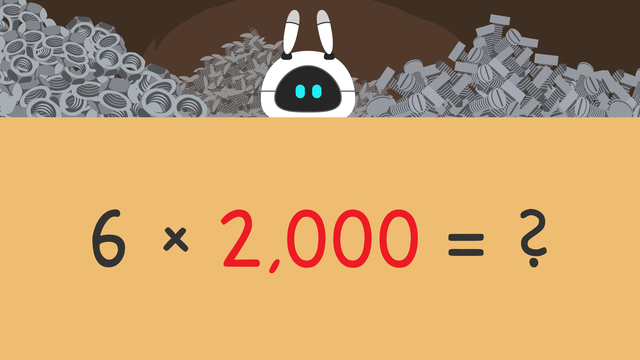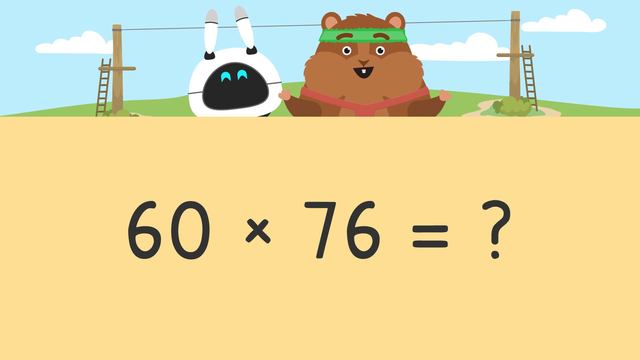Multiplying Tens — Let's Practice!
Basics on the topic Multiplying Tens — Let's Practice!
Multiplying Tens – Introduction
In this text, we will explore multiplying tens. This helps us understand larger numbers better. Together, we will practice solving multiplication problems involving tens.
Understanding Multiplying Tens – Explanation
Multiplying tens involves multiplying numbers where at least one of the numbers is a multiple of ten, like 10, 20, 30, and so on. The key to solving these problems is to multiply the non-zero digits first, and then add the appropriate number of zeros at the end.
For instance, when multiplying 2 by 40, you:
1.) Multiply the non-zero digits: 2 x 4 = 8.
2.) Insert the zero from the tens place: 80.

Let's break down the steps in more detail:
| Step # | Action | Description |
|---|---|---|
| 1 | Identify the non-zero digits | Look at the numbers you are multiplying and ignore the zeros for now. |
| 2 | Multiply the non-zero digits | Multiply the digits without considering the zeros. |
| 3 | Insert the zeros back | Count the total number of zeros from the numbers you multiplied and place them at the end of your product. |
Multiplying Tens – Example
Let's solve a problem step-by-step.
Problem: What is 2 times 40?
Solution: 1. Identify the non-zero digits: 2 and 4. 2. Multiply these digits: 2 x 4 = 8. 3. Insert the zero from 40 to the product: 80.
So, 2 times 40 equals 80.
Multiplying Tens – Guided Practice
Let's go through another problem together.
Multiplying Tens – Application
Now it's your turn! Solve the following problem on your own. Once done, check your answer below.
Problem: What is 6 times 30?

Multiplying Tens – Summary
Key Learnings from this Text:
- Multiplying tens involves multiplying the non-zero digits first.
- After multiplying the non-zero digits, insert the zeros from the tens place to the final answer.
- Practice makes perfect, so keep working on multiplying tens to master this skill!
Explore other content on our website platform for interactive practice problems, videos, and printable worksheets that will support your educational journey.
Multiplying Tens – Frequently Asked Questions
Transcript Multiplying Tens — Let's Practice!
Razzi says get these items ready, because today we're going to practice multiplying tens. It's time to begin! Solve two times forty. Pause the video to work on the problem, and press play when you are ready to see the solution! Write zero in the ones place, for the placeholder. Two times four equals eight. Two times forty equals eighty. Did you also get eighty? Let's tackle the next problem! Solve three times twenty. Pause the video to work on the problem, and press play when you are ready to see the solution! Write zero in the ones place. Three times two equals six. Three times twenty equals sixty. Did you also get sixty? Here comes the next problem! What is six times thirty? Pause the video to work on the problem, and press play when you are ready to see the solution! Write zero in the ones place. Six times three equals eighteen. Six times thirty equals one hundred eighty. Did you also get one hundred eighty? Let's tackle the final problem! Solve eight times fifty. Pause the video to work on the problem, and press play when you are ready to see the solution! Write zero in the ones place. Eight times five equals forty. Eight times fifty equals four hundred. Did you also get four hundred? Razzi had so much fun practicing with you today! See you next time!
Multiplying Tens — Let's Practice! exercise
-
Multiply and answer the questions.
HintsThe first step when multiplying tens is always to write down the 0 in the final answer.
The hundreds place is the red box.
The tens place is the blue box.
The ones place is the green box.
The placeholder always goes in the ones place.
Solution1. 0 is the place holder which goes in the ones place of the solution.
2. 3 x 4 = 12. The 1 goes in the hundreds place and the 2 goes in the tens place of the solution.
3. So the final solution is 30 x 4 = 120.
-
Do you know all the steps to multiply by tens?
HintsThe first step is to fill in the place holder.
When multiplying tens, what number will always be the place holder?
Remember:
The red box is the hundreds place.
The blue box is the tens place.
The green box is the ones place.
SolutionStep 1: Write 0 in the ones place
Step 2: Multiply 4 x 5
Step 3: Write 2 in the hundreds place and 0 in the tens place
Step 4: Read all numbers below the line to get the final answer
-
Multiply all equations.
HintsStep one when multiplying tens is always to fill in the 0.
Write it in the ones place shown by the green box.
Next, multiply the non-zero numbers.
Solution6 x 60 = 360
90 x 2 = 180
40 x 3 = 120
5 x 80 = 400
-
Multiplication practice.
HintsRewrite the problems as shown in the image.
Write the smaller factor, which is 7 in this equation, below the larger one.
Problem number 2 has a three-digit factor of 200.
Because there are two 0s in 200, write two placeholder 0s in the final answer, as shown in the image.
Even with large numbers, follow the same steps to solve the equation.
- Write the placeholder 0 in the ones place.
- Multiply the non-zero numbers.
Solution- 7 x 80 = 560
- 4 x 200 = 800
- 9 x 70 = 630
- 9 x 90 = 810
- 8 x 60 = 480
-
What is 3 x 30?
HintsThe first step is to fill in the place holder 0. It goes in the ones place.
Next, multiply 3 x 3. Write the answer in the tens place.
Solution3 x 30 = 90
-
Find the missing factor.
HintsSimplify the equation by crossing out one zero from the factor and one zero from the product, as shown in the image below.
Let's do problem #1 together.
After crossing out one zero from both the known factor and product, you can find the missing factor in two ways.
1. Divide 21 (the product) by 3 (the factor).
Or
- Count up from 0 to 21 by threes. How many times did you add 3? That's the missing factor!
Solution- 7 x 30 = 210
- 8 x 20 = 160
- 6 x 50 = 300
- 4 x 60 = 240














